Empirical Study of the Effect of Thermal Loading on the Heating Efficiency of Variable-Speed Air Source Heat Pumps
Abstract
1. Introduction
2. Materials and Methods
2.1. Measurement Method Overview
2.2. Cold Chamber Description
2.3. Instrumentation
2.4. Air Source Heat Pump Models and Controlling Their Thermal Output
2.5. Data Analysis Methodology
3. Results
3.1. Experimental Data
3.2. Analytical Function to Model COP as a Function of Temperature and Thermal Loading
4. Discussion
5. Conclusions
Author Contributions
Funding
Institutional Review Board Statement
Informed Consent Statement
Data Availability Statement
Acknowledgments
Conflicts of Interest
References
- Energy Consumption by Source, World. Available online: https://ourworldindata.org/grapher/energy-consumption-by-source-and-region (accessed on 26 July 2022).
- Ristinen, R.; Kraushaar, J.; Brack, J. Energy and the Environment, 3rd ed.; Wiley: Hoboken, NJ, USA, 2016. [Google Scholar]
- Air-Source Heat Pumps. Available online: https://www.energy.gov/energysaver/air-source-heat-pumps (accessed on 26 July 2022).
- Marsik, T.; Stevens, V. Air Source Heat Pumps in Cold/Arctic Climates. In Proceedings of the Thermal Systems in Cold/Arctic Climates Forum, Fairbanks, AK, USA, 21–24 January 2020. [Google Scholar]
- Northeast Energy Efficiency Partnerships. Cold Climate Air-Source Heat Pump Specification (Version 3.1); Northeast Energy Efficiency Partnerships: Boston, MA, USA, 2021; Available online: https://neep.org/sites/default/files/media-files/cold_climate_air-source_heat_pump_specification-version_3.1_update_.pdf (accessed on 26 July 2022).
- Northeast Energy Efficiency Partnerships. Northeast/Mid-Atlantic Air-Source Heat Pump Market Strategies Report 2016 Update; Northeast Energy Efficiency Partnerships: Boston, MA, USA, 2017; Available online: https://neep.org/sites/default/files/NEEP_ASHP_2016MTStrategy_Report_FINAL.pdf (accessed on 26 July 2022).
- Caskey, S.; Kultgen, D.; Groll, E.; Hutzel, W.; Menzi, T. Simulation of an Air-Source Heat Pump with Two-Stage Compression and Economizing for Cold Climates. In Proceedings of the International Refrigeration and Air Conditioning Conference, West Lafayette, IN, USA, 16–19 July 2012; Available online: http://docs.lib.purdue.edu/iracc/1278 (accessed on 31 July 2022).
- RDH Building Science Inc. BC Cold Climate Heat Pump Field Study; RDH Building Science Inc.: Victoria, BC, Canada, 2021; Available online: https://www.rdh.com/wp-content/uploads/2021/01/BC-Cold-Climate-Heat-Pump-Study-Final-Report.pdf (accessed on 26 July 2022).
- Winkler, J. Laboratory Test Report for Fujitsu 12RLS and Mitsubishi FE12NA Mini-Split Heat Pumps; National Renewable Energy Laboratory: Golden, CO, USA, 2011. Available online: https://www.nrel.gov/docs/fy11osti/52175.pdf (accessed on 31 July 2022).
- Williamson, J.; Aldrich, R. Field Performance of Inverter-Driven Heat Pumps in Cold Climates; Consortium for Advanced Residential Buildings, Steven Winter Associates, Inc.: Norwalk, CT, USA, 2015. Available online: https://www.nrel.gov/docs/fy15osti/63913.pdf (accessed on 30 July 2022).
- Pollard, A.; Berg, B. Heat Pump Performance, BRANZ Study Report SR414; BRANZ, Ltd.: Judgeford, New Zealand, 2018; Available online: https://www.researchgate.net/publication/330717027_Heat_pump_performance (accessed on 30 July 2022).
- U.S. Environmental Protection Agency. ENERGY STAR Program Requirements, Product Specification for Smart Thermostat Products, Eligibility Criteria, Draft 1 Version 2.0; U.S. Environmental Protection Agency: Washington, DC, USA, 2022. Available online: https://www.energystar.gov/sites/default/files/asset/document/ENERGY%20STAR%20Version%202.0%20%20Smart%20Thermostat%20Draft%201%20Program%20Requirements.pdf (accessed on 30 July 2022).
- Northeast Energy Efficiency Partnerships. Guide to Sizing & Selecting Air-Source Heat Pumps in Cold Climates; Northeast Energy Efficiency Partnerships: Boston, MA, USA, 2018; Available online: https://neep.org/sites/default/files/resources/ASHP%20Sizing%20%26%20Selecting%20-%208x11_edits.pdf (accessed on 31 July 2022).
- Northeast Energy Efficiency Partnerships. User Guide: Cold Climate Heat Pump Sizing Support Tools; Northeast Energy Efficiency Partnerships: Boston, MA, USA, 2022; Available online: https://ashp-production.s3.amazonaws.com/NEEP_ccASHP+Heating+Visualization+User+Guide_v2.2_TRC_04.01.22.pdf (accessed on 31 July 2022).
- CanmetENERGY. Air-Source Heat Pump Sizing and Selection Guide; Natural Resources Canada: Ottawa, ON, Canada, 2020. Available online: https://www.nrcan.gc.ca/sites/nrcan/files/canmetenergy/pdf/ASHP%20Sizing%20and%20Selection%20Guide%20(EN).pdf (accessed on 31 July 2022).
- Torregrosa-Jaime, B.; Martínez, P.J.; González, B.; Payá-Ballester, G. Modelling of a Variable Refrigerant Flow System in EnergyPlus for Building Energy Simulation in an Open Building Information Modelling Environment. Energies 2019, 12, 22. [Google Scholar] [CrossRef]
- Smith, I. Variable Speed Heat Pump Product Assessment and Analysis; Northwest Energy Efficiency Alliance: Portland, OR, USA, 2022; Available online: https://neea.org/resources/variable-speed-heat-pump-product-assessment-and-analysis (accessed on 31 July 2022).
- Bagarella, G.; Lazzarin, R.; Noro, M. Sizing strategy of on–off and modulating heat pump systems based on annual energy analysis. Int. J. Refrig. 2016, 65, 183–193. [Google Scholar] [CrossRef]
- Cold Climate Air Source Heat Pump Product List. Available online: https://ashp.neep.org/ (accessed on 31 July 2022).
- Wattnode T-WNB-3Y-208-P Data Sheet. Available online: https://www.testequipmentdepot.com/onset/pdf/twnb3y208p_datasheet.pdf (accessed on 3 December 2022).
- Magnelab SCT-0400 Series Spec Sheet. Available online: https://www.magnelab.com/wp-content/uploads/2015/02/SCT-0400-Spec-Sheet.pdf (accessed on 3 December 2022).
- Littlefuse PS Series Data Sheet. Available online: https://m.littelfuse.com/~/media/electronics/datasheets/leaded_thermistors/littelfuse_leaded_thermistors_interchangeable_thermistors_standard_precision_ps_datasheet.pdf.pdf (accessed on 3 December 2022).
- Honeywell HIH-4000 Series Product Sheet. Available online: https://prod-edam.honeywell.com/content/dam/honeywell-edam/sps/siot/en-us/products/sensors/humidity-with-temperature-sensors/hih-4000-series/documents/sps-siot-hih4000-series-product-sheet-009017-5-en-ciid-49922.pdf (accessed on 3 December 2022).
- Fujitsu 12RLS3H Submittal Data. Available online: https://www.fujitsugeneral.com/us/resources/pdf/support/downloads/submittal-sheets/12RLS3H.pdf (accessed on 2 October 2022).
- Daikin FTXS12LVJU/RXS12LVJU Submittal Data. Available online: https://backend.daikincomfort.com/docs/default-source/product-documents/residential/submittal/ftxs12lvju-rxs12lvju.pdf (accessed on 2 October 2022).
- Panasonic CS-XE12WKUAW/CU-XE12WKUA Submittal Data. Available online: https://panasonic.ca/brochures/EN/housing/heating-ac/CS-XE12WKUAW_Submittal_Ver3.0_en.pdf (accessed on 2 October 2022).
- Daikin FTX15NMVJU/RXL15QMVJUA Submittal Data. Available online: https://backend.daikincomfort.com/docs/default-source/product-documents/residential/submittal/ftx15nmvju-rxl15qmvjua-submittal.pdf (accessed on 2 October 2022).

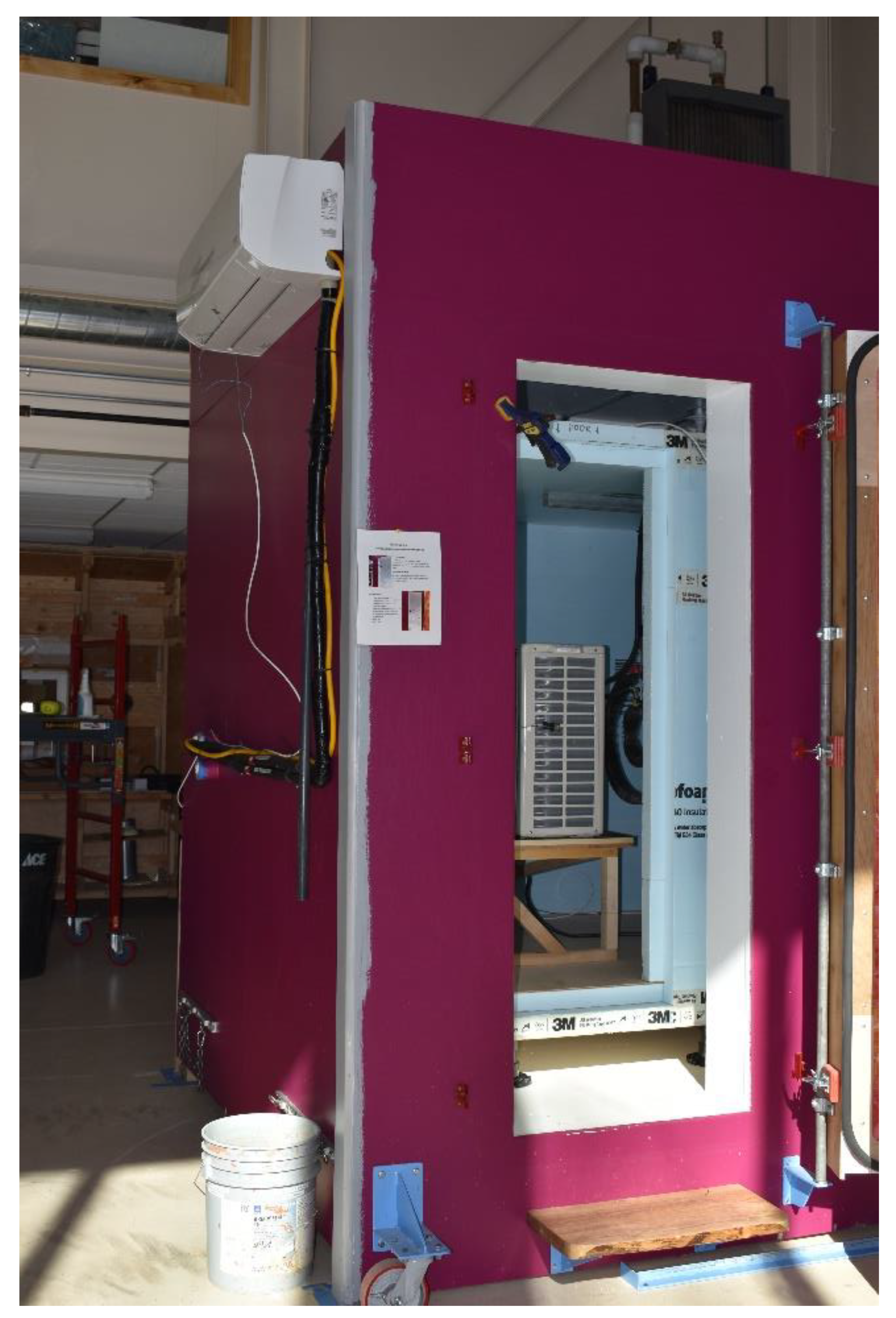
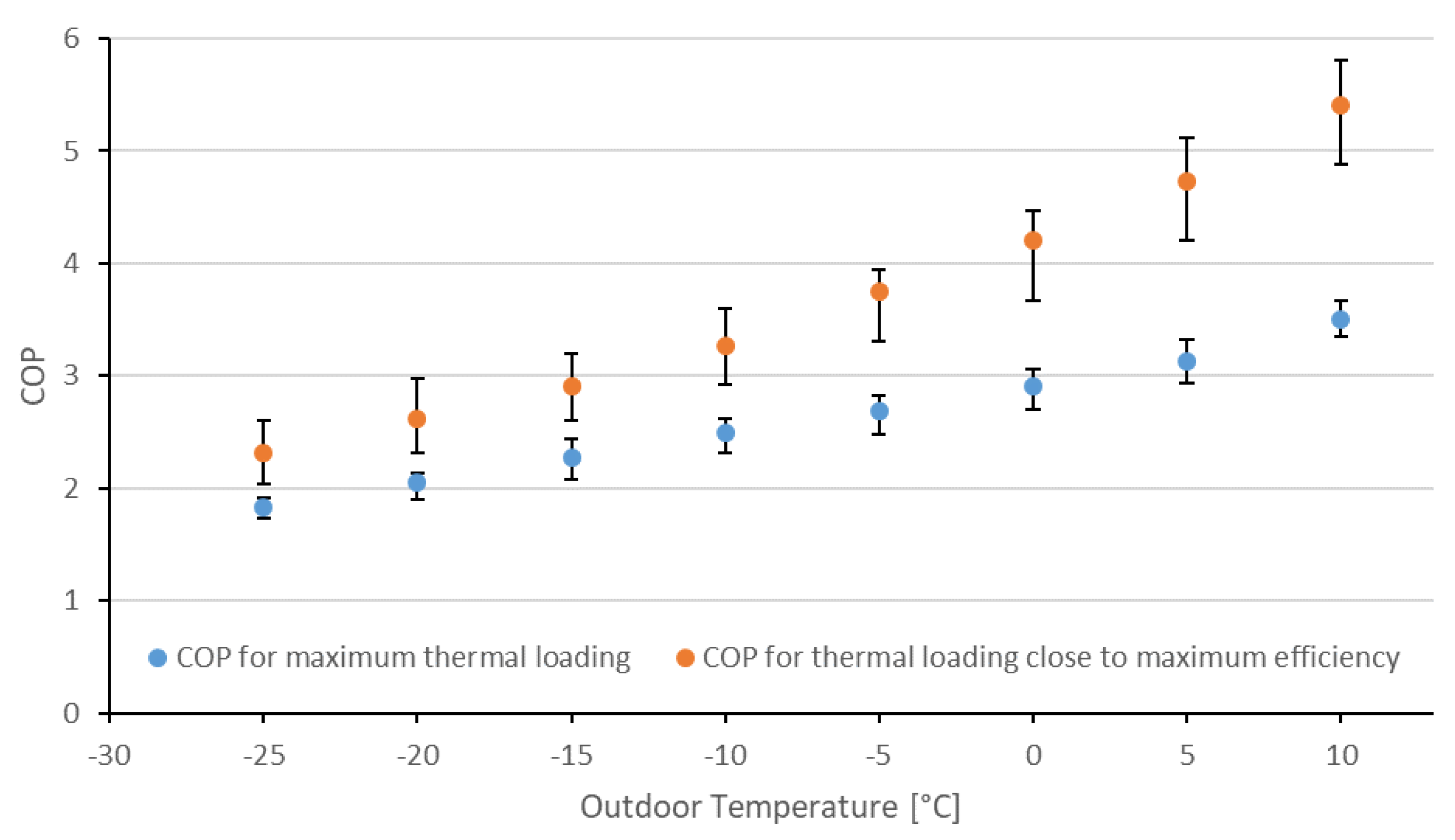
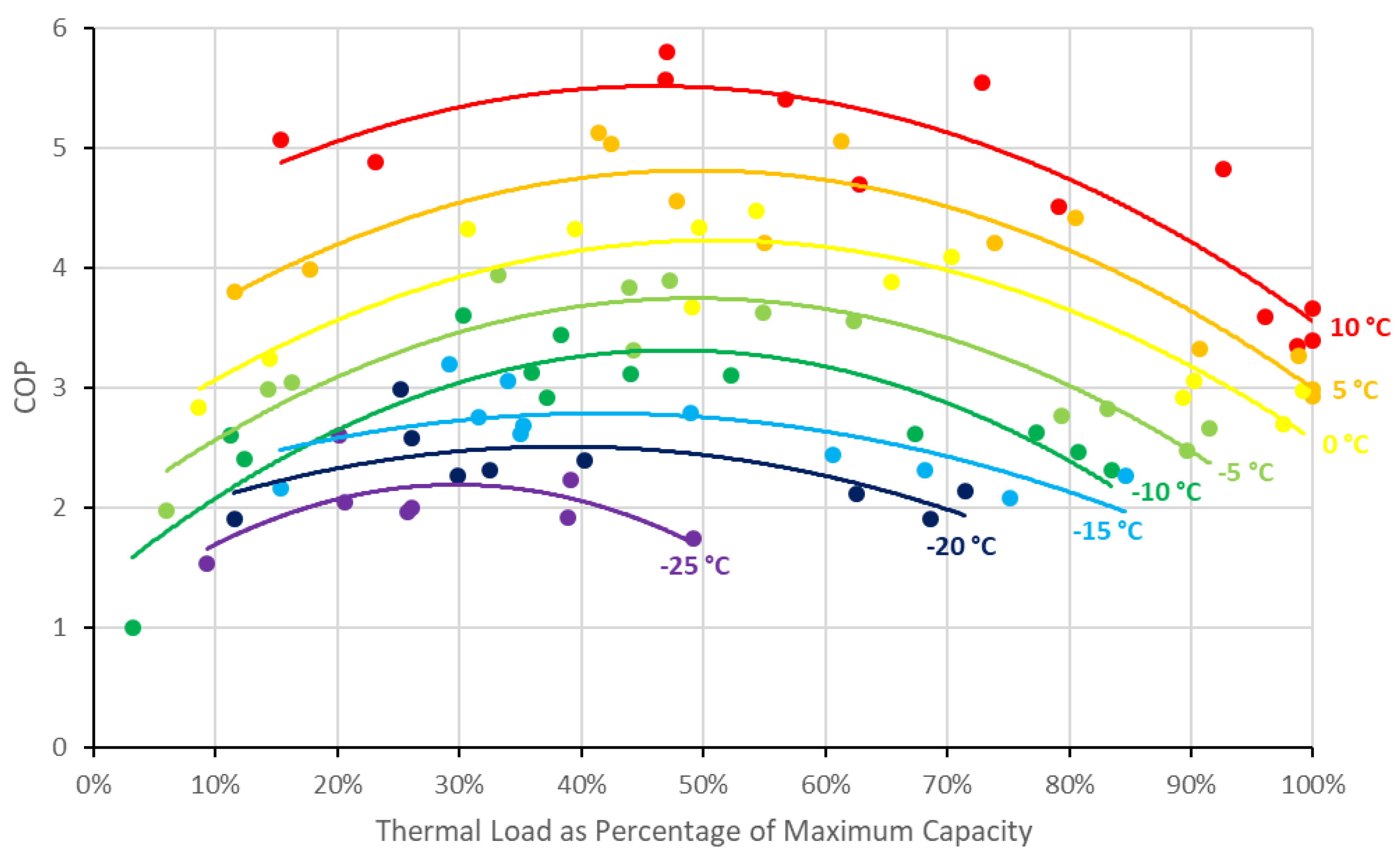
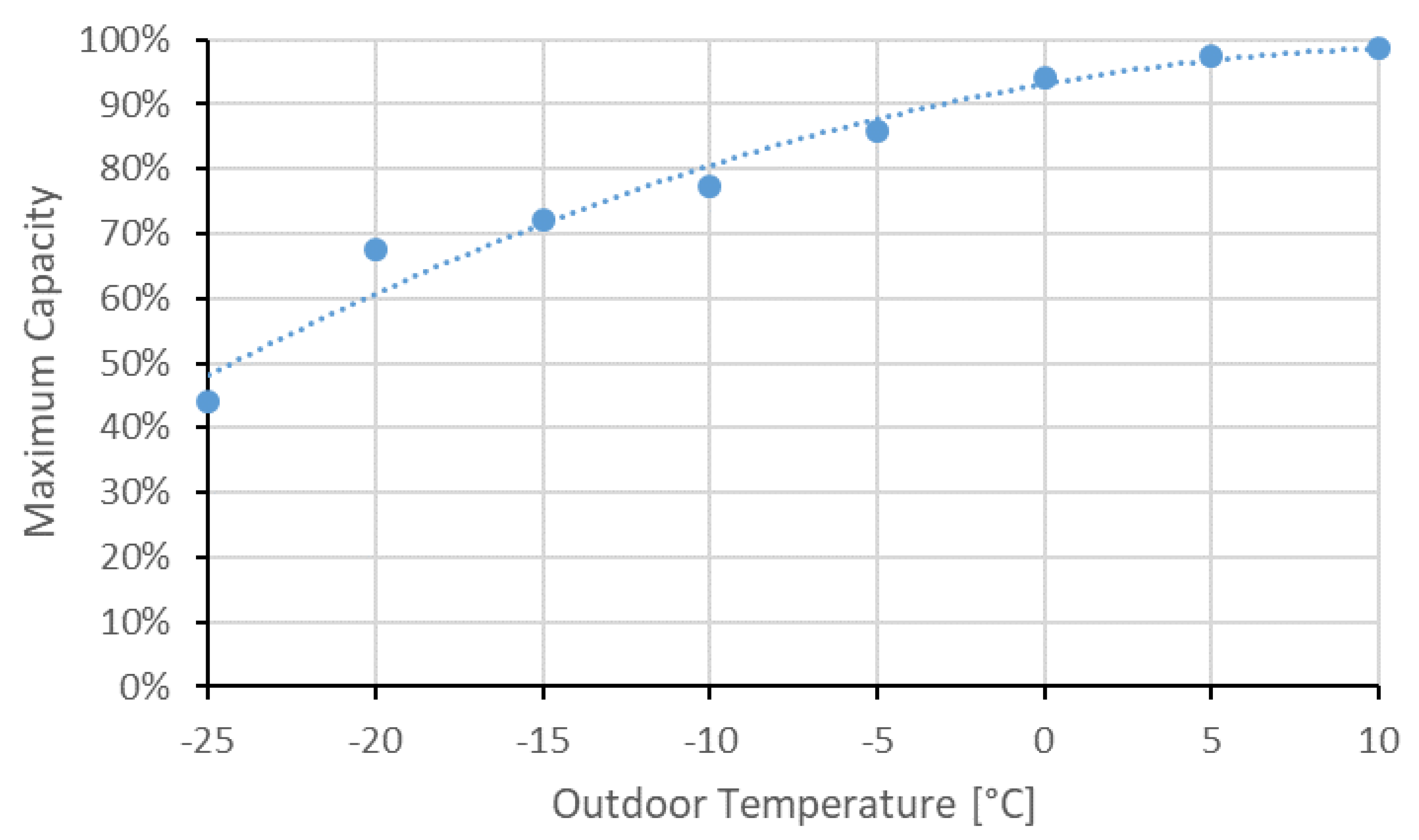
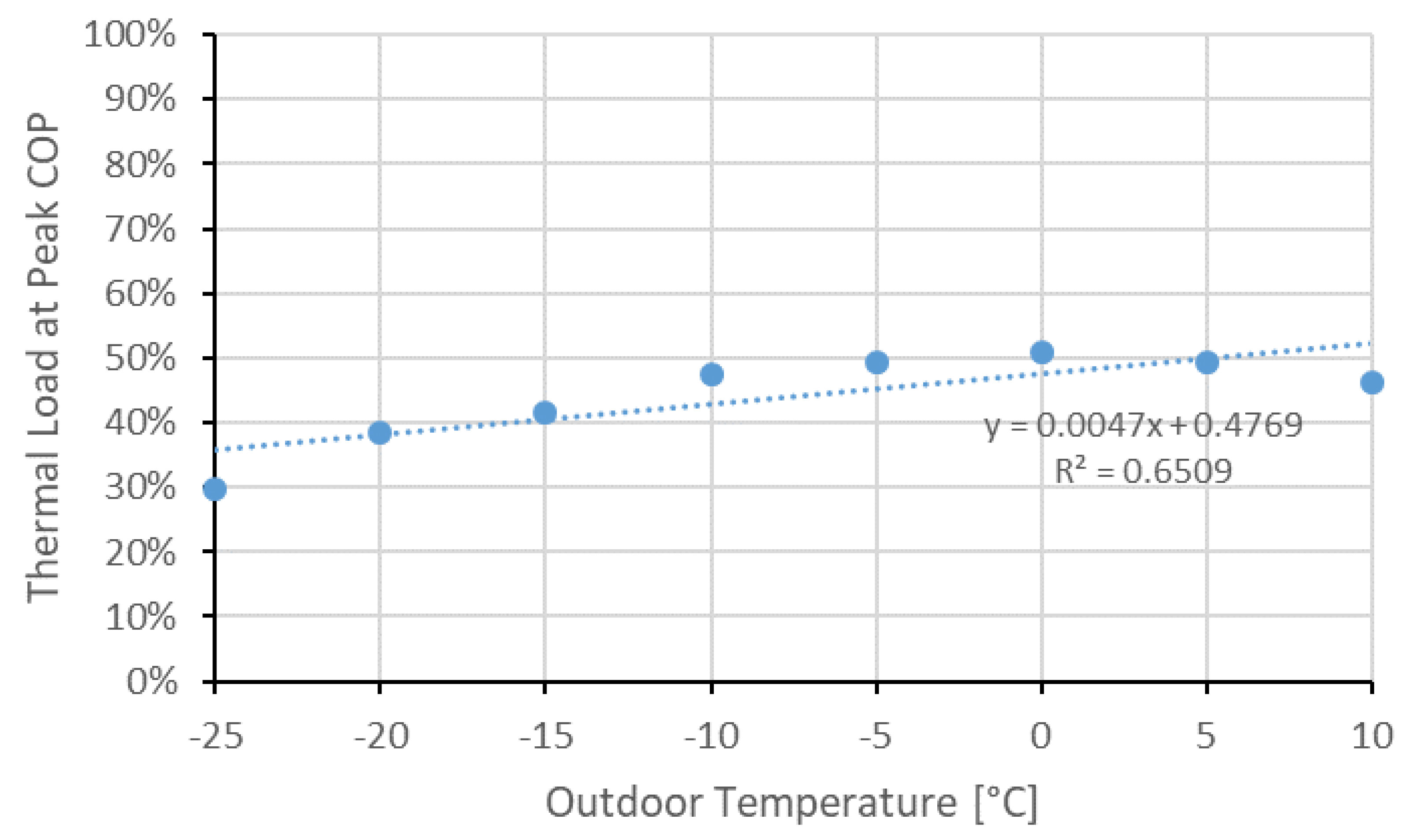
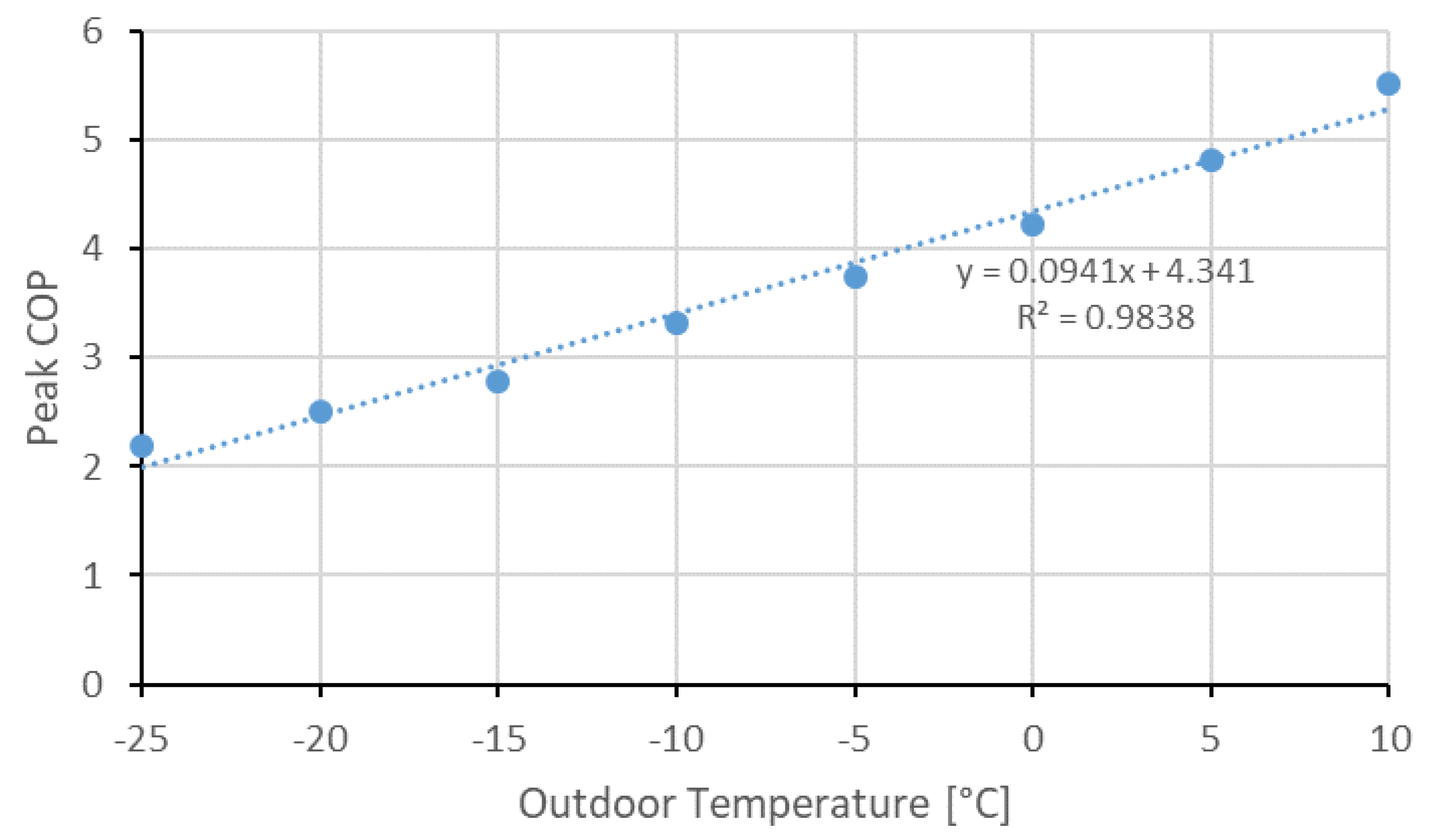
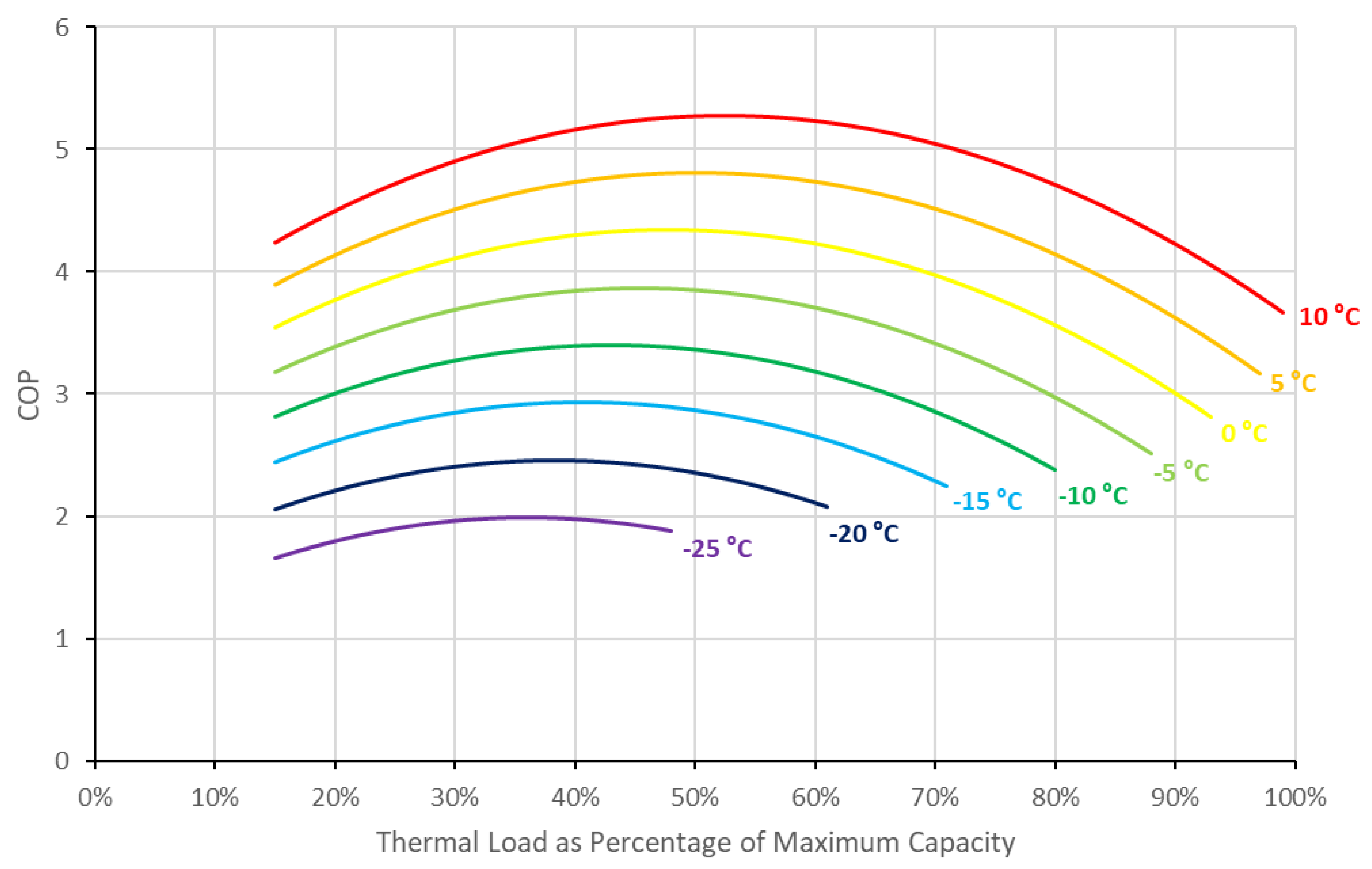
| Cold Chamber Interior | Metering Box Interior | |
|---|---|---|
| Width | 1.83 m (6 ft) | 1.32 m (4.33 ft) |
| Length | 2.91 m (9.56 ft) | 2.23 m (7.33 ft) |
| Height | 2.29 m (7.5 ft) | 1.52 m (5 ft) |
| Sensor | Purpose |
|---|---|
| Temperature– Outdoor unit heat exchanger | To identify defrost cycles of the heat pump and serve as a check that other sensors are functioning properly. |
| Temperature and RH– Metering box | These sensors were placed inside the metering box and measured the “outdoor” temperature and relative humidity seen by the heat pump. |
| Temperature and RH– Chamber | These sensors were placed inside the cold chamber, but outside the metering box, to monitor respective environmental conditions. |
| Temperature– Indoor unit inlet | This measured the air temperature on the inlet of the indoor unit of the heat pump, which means the temperature of the “room” that the heat pump was heating. |
| Temperature– Indoor unit outlet | This was used to verify when the heat pump was providing space heating. |
| Heat Pump Model | Outdoor Unit Model Number | Indoor Unit Model Number | Rated COP | Low Temperature Limit |
|---|---|---|---|---|
| Fujitsu RLS3H | AOU12RLS3H | ASU12RLS3Y | 4.64 | −26 °C |
| Daikin LV | RXS12LVJU | FTXS12LVJU | 4.35 | −15 °C |
| Panasonic ClimaPure XE | CU-XE12WKUA | CS-XE12WKUAW | 4.39 | −26 °C |
| Daikin Aurora | RXL15QMVJUA | FTX15NMVJU | 4.0 | −25 °C |
Disclaimer/Publisher’s Note: The statements, opinions and data contained in all publications are solely those of the individual author(s) and contributor(s) and not of MDPI and/or the editor(s). MDPI and/or the editor(s) disclaim responsibility for any injury to people or property resulting from any ideas, methods, instructions or products referred to in the content. |
© 2023 by the authors. Licensee MDPI, Basel, Switzerland. This article is an open access article distributed under the terms and conditions of the Creative Commons Attribution (CC BY) license (https://creativecommons.org/licenses/by/4.0/).
Share and Cite
Marsik, T.; Stevens, V.; Garber-Slaght, R.; Dennehy, C.; Strunk, R.T.; Mitchell, A. Empirical Study of the Effect of Thermal Loading on the Heating Efficiency of Variable-Speed Air Source Heat Pumps. Sustainability 2023, 15, 1880. https://doi.org/10.3390/su15031880
Marsik T, Stevens V, Garber-Slaght R, Dennehy C, Strunk RT, Mitchell A. Empirical Study of the Effect of Thermal Loading on the Heating Efficiency of Variable-Speed Air Source Heat Pumps. Sustainability. 2023; 15(3):1880. https://doi.org/10.3390/su15031880
Chicago/Turabian StyleMarsik, Tom, Vanessa Stevens, Robbin Garber-Slaght, Conor Dennehy, Robby Tartuilnguq Strunk, and Alan Mitchell. 2023. "Empirical Study of the Effect of Thermal Loading on the Heating Efficiency of Variable-Speed Air Source Heat Pumps" Sustainability 15, no. 3: 1880. https://doi.org/10.3390/su15031880
APA StyleMarsik, T., Stevens, V., Garber-Slaght, R., Dennehy, C., Strunk, R. T., & Mitchell, A. (2023). Empirical Study of the Effect of Thermal Loading on the Heating Efficiency of Variable-Speed Air Source Heat Pumps. Sustainability, 15(3), 1880. https://doi.org/10.3390/su15031880







